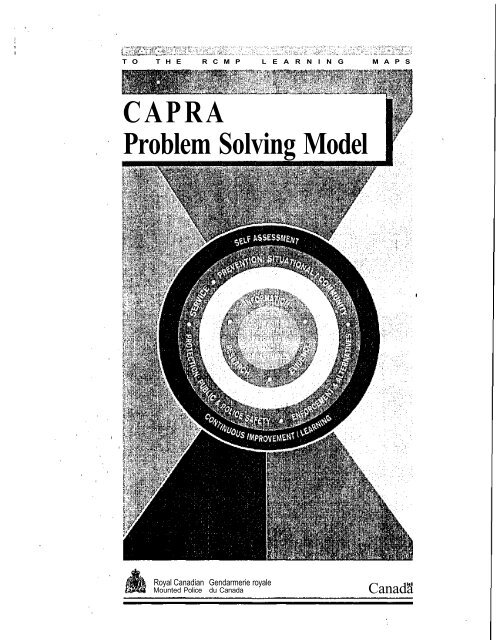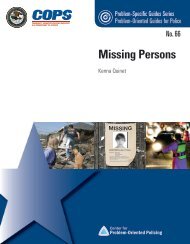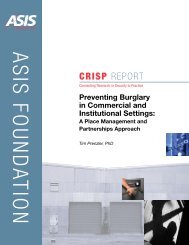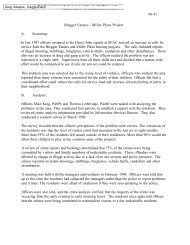CAPRA Problem Solving Model Booklet - Center for Problem ...
CAPRA Problem Solving Model Booklet - Center for Problem ...
CAPRA Problem Solving Model Booklet - Center for Problem ...
You also want an ePaper? Increase the reach of your titles
YUMPU automatically turns print PDFs into web optimized ePapers that Google loves.
T O T H E R C M P L E A R N I N G M A P S<br />
<strong>CAPRA</strong><br />
<strong>Problem</strong> <strong>Solving</strong> <strong>Model</strong><br />
Royal Canadian Gendarmerie royale<br />
Mounted Police du Canada<br />
Canada
INTRODUCTION<br />
This is a learning tool designed to increase your understanding of<br />
the RCMP Community Policing <strong>Problem</strong> <strong>Solving</strong> <strong>Model</strong>, <strong>CAPRA</strong>. It is<br />
intended to promote discussion in small groups of employees, clients<br />
and partners of the Royal Canadian Mounted Police. By following the<br />
discussion points below, you can learn more about community policing,<br />
and how its principles apply to how we work as an organization.<br />
Community policing is defined by the RCMP as problem solving in partnership<br />
with clients/communities to ensure continuous improvement in<br />
service delivery. You can share thoughts and ideas with the members<br />
of your group, and discuss how the RCMP can best work with communities<br />
to provide quality service.<br />
This learning map is designed with open space to write down any<br />
ideas and suggestions. (Erasable, black, dry markers or sticky notes<br />
are ideal <strong>for</strong> this purpose.) The discussion points below will help you<br />
understand how a problem solving approach could help you to better<br />
resolve your work-related challenges.<br />
GETTING STARTED<br />
^<br />
The images on this map are an extension of the ideas presented in<br />
The Evolution of Policing in the RCMP map. The evolution map provides<br />
an insight into the necessity <strong>for</strong> changes to police service delivery.<br />
<strong>CAPRA</strong> is a model <strong>for</strong> providing quality service, protection, en<strong>for</strong>cement<br />
and prevention, in partnership with clients/communities within<br />
today's context.<br />
The model emphasizes the importance of:<br />
• developing and maintaining partnerships and trust within<br />
communities/the work<strong>for</strong>ce to establish priorities <strong>for</strong> service<br />
delivery and preventive problem solving;<br />
• understanding our clients' perspectives on work-related<br />
matters <strong>for</strong> establishing priorities and potential partnerships<br />
in service delivery; and<br />
• encouraging ongoing feedback <strong>for</strong> continuous improvement.<br />
<strong>CAPRA</strong> is a unique operational model in that it provides an opportunity<br />
<strong>for</strong> you to exercise any combination of service, protection,<br />
prevention and en<strong>for</strong>cement, whether a problem exists or a potential<br />
problem can be prevented. <strong>CAPRA</strong> is more than a problem solving<br />
model. It is designed to assist the police officer or other members of<br />
the work <strong>for</strong>ce to anticipate problems and to prevent problems from<br />
arising, where appropriate, in consultation with partners, as much as<br />
it is to resolve problems through multi-disciplinary, inter-agency and
consultative processes. It applies to en<strong>for</strong>cement as much as it does to<br />
prevention. It applies to every aspect of police internal organizational<br />
service delivery. It is a method of service delivery that focuses on providing<br />
the best quality service by reflecting an understanding of clients'<br />
needs, demands and expectations and, where possible, using partnership<br />
approaches.<br />
The objective of this discussion/exercise, then, is to provide you<br />
with practice in applying the model to:<br />
• identifying existing or potential problems and related issue;<br />
• acquiring and analysing pertinent in<strong>for</strong>mation;<br />
• enlisting appropriate partners <strong>for</strong> the situation at hand;<br />
• generating and selecting responses [options); and<br />
• continuously improving service delivery.<br />
Group discussions are ideal <strong>for</strong> this purpose, because they give you<br />
the opportunity to build on other people's ideas. You'll see how<br />
<strong>CAPRA</strong> applies to a variety of work environments that involve challenges<br />
with:<br />
• policy<br />
• front-line work<br />
• police management issues<br />
For today, read the narrative in<strong>for</strong>mation out loud (represented by<br />
the *J* symbol). The questions that follow are intended to stimulate<br />
group discussions. On our own, we often come up with great ideas on<br />
how to solve our own problems, but group discussion of these issues<br />
will almost always result in a more manageable and effective solution.<br />
Some anticipated responses have been listed to assist you in stimulating<br />
discussion, if necessary.<br />
As the facilitator, estimate how much time you might spend on each<br />
section of the diagram be<strong>for</strong>e you start the session. It's a good idea to<br />
leave some time at the end of the session <strong>for</strong> discussion of findings, an<br />
assessment of the session and next steps (e.g., how to use this new<br />
in<strong>for</strong>mation).<br />
Be<strong>for</strong>e you start, remind group members that there are no right or<br />
wrong answers; some people may interpret the images and questions<br />
differently, given their backgrounds and working environments.<br />
Debate should be encouraged when appropriate.
SECTION ONE<br />
C = Clients<br />
• The left side of the diagram shows an open faced building<br />
in which a meeting is being conducted. A consultative meeting<br />
is one method of getting to know your clients. There are different<br />
participants around the table, discussing and taking note of<br />
the issues that concern them.<br />
The purpose of this meeting is to allow all participants to learn<br />
one another's point of view. It promotes a better understanding<br />
of what causes concern, <strong>for</strong> whom, and why. Through this<br />
process, participants can clearly define and prioritize their problems<br />
and concerns. The result is that proposed directions or<br />
solutions will better address all participants' concerns and thus<br />
be more likely to enlist their commitment to partnership<br />
approaches in this and future situations. •<br />
Who are direct clients? Indirect clients?<br />
• Direct clients are people with whom you come into contact<br />
on a daily basis in service delivery or in problem-solving<br />
situations and include individual citizens (suspects, victims,<br />
witnesses, concerned citizens, etc.) concerned citizen<br />
groups, internal clients (SEC, policy centres, regions, divisions,<br />
individual employees, etc.) and various agencies and<br />
departments.<br />
• Indirect clients are people with whom you do not necessarily<br />
come into direct contact, but who are affected by the outcome<br />
of your ef<strong>for</strong>ts. These indirect clients might include<br />
business communities (where, <strong>for</strong> example, a series of<br />
thefts have occurred); interest groups (e.g. women's<br />
groups, where, <strong>for</strong> example, a sexual assault has occurred);<br />
cultural groups (where, <strong>for</strong> example, discriminatory practices<br />
have occurred in the workplace); taxpayers (where, <strong>for</strong><br />
example, expenditures exceed value added).<br />
What are some other ways of "getting to know" your clients?
• We should be continuously renewing our working relationships<br />
to ensure that the services we provide and the partnerships<br />
we establish are helping to ensure safe homes and communities<br />
and a productive working environment. By establishing trust<br />
within clients/communities, we gain access to in<strong>for</strong>mation,<br />
which is essential to preventing and resolving crime-related or<br />
internal organizational problems. The better we know the capabilities<br />
of our partners, the more likely we are to quickly and<br />
effectively address situations that arise.<br />
For example:<br />
• How well do you actually know your clients? What are their<br />
needs, demands, expectations?<br />
• What is the nature of your relationship with your clients?<br />
• Who is affected by the work that you do?<br />
* How do you suppose it would affect them?<br />
Getting to know your clients promotes efficiency. You know<br />
what expectations you are facing, and can there<strong>for</strong>e more effectively<br />
address people's concerns. Such knowledge can also help<br />
you to more appropriately allocate resources. It gives you time to<br />
develop appropriate plans and strategies from a well in<strong>for</strong>med<br />
perspective. Your commitment to finding a mutually agreed solution<br />
to a shared problem will serve both you and your client<br />
well.*>
SECTION TWO<br />
A = Acquire/Analyse In<strong>for</strong>mation<br />
• The map provides examples of who to turn to <strong>for</strong> in<strong>for</strong>mation<br />
-- people you work with, people who work in community<br />
police offices, the town hall, a banking institution, a restaurant, a<br />
school and citizens generally. In<strong>for</strong>mation collected as part of a<br />
community profiling process, or a work orientation session will<br />
be of value to you in future problem-solving situations. •<br />
What is the importance of acquiring and analysing in<strong>for</strong>mation?<br />
• to fully understand what the problem is, what the issues are,<br />
who is involved , where and when the situation occurred<br />
and how it might best be addressed - given your direct and<br />
indirect clients' perspectives; ,<br />
• to identify competing interests (needs, demands and expectations)<br />
;<br />
• to put yourself in the best position to manage the competing<br />
interests in a manner that will ensure that al! participants feel<br />
that the situation was handled fairly;<br />
• to determine who your primary client should be, and<br />
• to determine what your options are and what the best solution<br />
might be.<br />
• The more in<strong>for</strong>mation you have and the better your analysis<br />
in terms of the clients' perspectives, the more likely you are to<br />
define the problem appropriately in terms of the clients' needs<br />
and arrive at a mutually agreed response or solution to a problem.<br />
Keep in mind that the in<strong>for</strong>mation you acquire and analyse will<br />
also in<strong>for</strong>m you of what's best <strong>for</strong> the clients, in terms of balancing<br />
their sometimes competing interests. •><br />
What competencies might you employ in order to understand<br />
and be able to use the in<strong>for</strong>mation you have acquired, to better<br />
solve on-the-job problems?<br />
• crime analysis<br />
• leadership
SECTION THREE<br />
P = Partnerships<br />
• Developing and maintaining partnerships is the third element<br />
of this operational model. Partners are individuals or<br />
groups who can assist you in providing quality service. They<br />
may be internal or external to the RCMP or your unit within the<br />
RCMP. Partnerships, like friendships, are established, based on<br />
trust. People who feel that they have been fairly treated in the<br />
past will not hesitate to assist you in subsequent endeavours. In<br />
the interest of ensuring timely and quality responses, partnerships<br />
should be established be<strong>for</strong>e there is a problem and contingency<br />
plans should be established to address the most typical<br />
kinds of work-related situations that arise. Partnerships should<br />
result in mutual benefits.•<br />
Who are your partners in your work situation?<br />
• colleagues<br />
• specialized units<br />
• experts<br />
• witnesses<br />
* community groups<br />
* DSRRs<br />
i<br />
What competencies might you need to establish partnerships?<br />
• integrity<br />
• leadership<br />
• effective communication<br />
• interpersonal skills<br />
• client orientation<br />
• the ability to recognize shared interests<br />
• respect <strong>for</strong> human dignity<br />
How should you approach establishing partnerships?<br />
• identify the potential roles of the partners in police/workrelated<br />
matters<br />
• identify shared interests and concerns<br />
• prioritize your concerns<br />
• establish the benefits of working together
• establish contingency plans or an action plan<br />
• establish evaluation criteria to assess mutually agreed<br />
directions<br />
• agree to provide continual feedback to ensure continuous<br />
improvement culture?<br />
• You may wish to gather in<strong>for</strong>mation that you feel may be<br />
relevant about the agency/person with whom you wish to partner.<br />
You may be able to do this from a pamphlet or from someone<br />
you know who works at the agency or with the individual.<br />
From here, you can arrange an in<strong>for</strong>mal meeting, whether it be<br />
by phone, or in person. The in<strong>for</strong>mation you collect in advance<br />
of a meeting will likely give you insights on how to more effectively<br />
reach your common goals. •
SECTION FOUR<br />
R = Response<br />
• Once you have identified a potential or existing problem and<br />
related issues, understood who your clients are and their needs<br />
and gathered and analysed relevant in<strong>for</strong>mation from appropriate<br />
sources and partners, you should be ready to generate, with your<br />
partners, if appropriate, response options and select the best<br />
response in light of your primary clients' needs.•><br />
Here is a list and a brief explanation of types of responses<br />
available to you:<br />
Service:<br />
• products and assistance to clients (public, communities,<br />
individual citizens, directorates/divisions/regions, branches,<br />
units or individual employees). Referral of the public to<br />
partner agencies, assistance to employees through partners<br />
in support programs. Provision of in<strong>for</strong>mation and training.<br />
Protection:<br />
• of the public interest, victims, or individuals or groups of<br />
employees affected by the problem {e.g., safety issues), in<br />
partnership with community agencies and experts, where<br />
appropriate.<br />
En<strong>for</strong>cement and Alternatives:<br />
• en<strong>for</strong>cement will always be an important part of policing, as<br />
it is the mandate of the police to uphold the law. As statistics<br />
show, however, en<strong>for</strong>cement alone is not always the<br />
best response -- it does not always deter people from<br />
breaking the law, and doesn't address why the law was broken<br />
in the first place. Some problems, such as a general<br />
fear of crime or community disputes, do not lend themselves<br />
readily to en<strong>for</strong>cement. Law, policy and regulations<br />
en<strong>for</strong>cement apply in the work place as well (RCMP Act,<br />
Official Languages Act, Administration Manual, etc.).
• communication skills<br />
• interpersonal skills<br />
• time management skills<br />
• research skills<br />
• client orientation<br />
Who/what are potential sources of in<strong>for</strong>mation <strong>for</strong> analysis?<br />
• police dog services<br />
• hospitals<br />
• CPIC/PIRS database<br />
• libraries<br />
• community task <strong>for</strong>ces<br />
• an experienced co-worker/expert
Prevention:<br />
• preventing the problem from occurring or from escalating<br />
by addressing contributing factors to the broad problem<br />
rather than specific incidents or manifestations of the issue.<br />
Prevention applies both within the organization and police<br />
service delivery.<br />
• Depending on your goals which can range from problem<br />
elimination or reduction; reduction of harm/impact; improvement<br />
of response and reallocation of responsibility, you can use<br />
any combination of these four types of responses.<br />
There are a number of strategies you can use: providing in<strong>for</strong>mation,<br />
education; establishing community preventative programs/inter-agency<br />
approaches to service delivery/community<br />
regulations; community mobilization; and use of alternatives to<br />
en<strong>for</strong>cement approaches to problem resolution. Focused attention<br />
to response options available may lead you to solutions different<br />
from those you might instinctively have chosen. Once you<br />
have selected an option, you may require additional in<strong>for</strong>mation<br />
to implement it. •<br />
Why is it important to set goals and keep notes on actions<br />
taken?<br />
• to select the best option to accomplish the goal<br />
• to monitor the effectiveness of the option selected<br />
• to select different options where appropriate to ensure that<br />
the goals are, in fact, met.
SECTION FIVE<br />
A = Assessment of Action taken<br />
• On the map, all of the images that show communication<br />
between the police and the community, represent assessment and<br />
evaluation <strong>for</strong> continuous improvement. Similarly, communication<br />
among RCMP units, branches, directorates, divisions and<br />
regions is essential to continuous improvement. Continuous<br />
feedback helps to ensure that you are indeed delivering services<br />
that the community/your clients, need and want. Evaluation<br />
seeks to avoid the maintenance of 'stale' services, services which,<br />
as a result of constantly changing situations and demands, no<br />
longer add value. •<br />
What do you think are the key points of assessment?<br />
• to establish agreed to criteria <strong>for</strong> evaluation that address<br />
value added and quality service<br />
• to compare service delivered to internally and/or externally<br />
agreed to standards<br />
• to ensure that clients are included in the feedback loop<br />
• to assess per<strong>for</strong>mance and possible areas <strong>for</strong> improvement<br />
• to identify trends and opportunities <strong>for</strong> prevention<br />
Here are some tips to ensure that your assessment yields<br />
effective results.<br />
• At the outset, determine appropriate time lines <strong>for</strong> evaluation,<br />
but be prepared to adapt them as required.<br />
• Determine what method of assessment you might use --<br />
self analysis; input from clients and communities; statistical<br />
analyses; examination of trends (be<strong>for</strong>e and after).<br />
• When choosing your response, keep your goals in mind.<br />
Write them down and keep them realistic and simple.<br />
• Take note of unexpected consequences of actions taken,<br />
both negative and positive.<br />
• Note what worked particularly well and what did not and<br />
identify contributing factors. (This has implications <strong>for</strong> how<br />
you might respond in the future.)
SECTION SIX<br />
Into the real world<br />
how does it work?<br />
• Let's review the <strong>CAPRA</strong> model at the bottom centre of this<br />
diagram. At the core are a variety of clients. Their perspectives<br />
are essential to appropriate identification of problems and issues.<br />
Their concerns will in<strong>for</strong>m police priorities. They are sources of<br />
in<strong>for</strong>mation that will in<strong>for</strong>m the selection of effective response<br />
options. They are potential partners in service delivery. Finally,<br />
their feedback is essential to the continuous improvement of<br />
police service delivery. <strong>CAPRA</strong> then is a client-centred, community<br />
policing problem solving model which by design will lead to<br />
continuous learning and improvement •<br />
NOTE TO FACILITATOR: at the end of this booklet are questionnaires<br />
that can be photocopied and distributed to each group.<br />
Each scenario is divided into several parts <strong>for</strong> hand outs when<br />
appropriate.<br />
13
<strong>CAPRA</strong> in action - a police-related situation<br />
PART I OF SCENARIO<br />
• A school principal is receiving complaints from the school<br />
bus drivers because people are not using the designated crosswalk<br />
in front of the school. Also, cars are parked inappropriately.<br />
NOTE : Hand out Part I of Scenario<br />
Who are the clients (direct, indirect)?<br />
• The direct clients are the school bus driver and the school<br />
principal. The indirect clients are the pedestrians whose<br />
safety may be at risk and their parents, families and/or<br />
friends.<br />
What seems to be the problem? What are the issues?<br />
i<br />
• The problem is not yet clear. It seems to be a safety concern<br />
of the bus driver caused by people not using the crosswalk<br />
and inappropriately parked cars.<br />
What are your clients' perspectives on the problem (needs,<br />
demands, expectations)?<br />
• The clients' perspectives on the problem are not yet known.<br />
This in<strong>for</strong>mation must be obtained through interviews with<br />
them.<br />
What additional in<strong>for</strong>mation is needed?<br />
• Additional in<strong>for</strong>mation should be gathered through observation<br />
of the situation at the times of arrival and departure<br />
from the school.<br />
What/Who are the sources <strong>for</strong> that in<strong>for</strong>mation?<br />
• Sources of in<strong>for</strong>mation include the school bus drivers,<br />
principal, and school crossing guards.<br />
Who are your potential partners in defining the problem and<br />
acquiring the in<strong>for</strong>mation?<br />
• Potential partners include the school principal who could<br />
communicate cautions to the children, the coordinator of the<br />
crossing guard program and crossing guards, community<br />
14
media (newspapers, radio, television), and the municipality<br />
with regard to bylaws and availability of safe parking spots<br />
and clearly designated crosswalks.<br />
How will you acquire and analyse the in<strong>for</strong>mation in partnership,<br />
where possible and appropriate?<br />
• Talk to the principal, bus drivers and crossing guards and<br />
observe the situation when students are being dropped off<br />
and picked up from school, to determine the problem and<br />
possible solutions. Have a meeting with those involved to<br />
select options.<br />
PART II OF SCENARIO<br />
• You visit the school and interview the principal. He tells<br />
you that parents who come to pick up their children after school<br />
often ignore the student crosswalk and jaywalk across the street<br />
to their parked cars. The bus drivers cannot pull out <strong>for</strong> fear of<br />
hitting pedestrians. Cars are being parked in private driveways,<br />
and in front of "No Parking" signs. You speak to several of the<br />
crossing guards, who are parents and doing the work on a voluntary<br />
basis, and they tell you that they are given no respect and<br />
what they do is a joke. You observe the arrival and departure of<br />
vehicles on a school day and discover that the same situation<br />
exists when children are dropped off at the school in the morning.<br />
•<br />
NOTE : Hand out Part II of Scenario<br />
In light of the additional in<strong>for</strong>mation you gathered:<br />
What is the problem?<br />
• Now more clients have been identified (parents, children<br />
and crossing guards). The problem is more clearly related<br />
to safety and the expectations of the caller seem to be that<br />
the police could assist in preventing this situation from<br />
recurring.<br />
What are the issues?<br />
• A number of issues have been raised:<br />
i) Parents are setting a bad example <strong>for</strong> the children, by<br />
jaywalking.<br />
ii) The crossing guards see their ef<strong>for</strong>ts as making no
difference.<br />
iii) Inadequate legal parking spots available <strong>for</strong> drop off and<br />
pick up of children.<br />
iv) The bus drivers are concerned <strong>for</strong> the safety of both the<br />
children and the parents jaywalking, and darting out in front<br />
of the buses, and other traffic.<br />
Is there additional in<strong>for</strong>mation that you require (e.g., why the<br />
rules are being ignored)?<br />
• It would be important to understand why the rules are being<br />
ignored be<strong>for</strong>e considering options. (For example, have<br />
the offending parents considered the potential consequences<br />
of their actions and the message of disrespect <strong>for</strong><br />
the law that their behaviour is conveying to their children?)<br />
What options are available?<br />
• The options available are varied and involve different<br />
potential partners:<br />
Which partners can you work with?<br />
• Principal, parents associations or representatives, municipality,<br />
student council, crossing guards coordinator and crossing<br />
guards.<br />
Which option (s) would you select?<br />
• Meet with partners, together if possible to come up with<br />
possible solutions. Have designated pick up and drop off<br />
zones. Issue tickets and have vehicles towed.<br />
The options available are varied and involve different potential<br />
partners:<br />
NOTE : Hand out Chart of Scenario<br />
16
OPTIONS<br />
1. Designated drop off/<br />
pick-up zones <strong>for</strong><br />
children transported by<br />
parents at a distance<br />
from the bus stop.<br />
2. Move the crosswalk<br />
further away from the<br />
bus stop.<br />
3. Establish an intermittent<br />
schedule <strong>for</strong> buses<br />
and vehicle pick ups<br />
and drop offs.<br />
4. Have police ticket jaywalkers<br />
and vehicles<br />
illegally parked. Have<br />
repeat offenders towed.<br />
5. Have a problem solving<br />
session with all of the<br />
players<br />
PARTNERS<br />
Municipality, school<br />
personnel, crossing<br />
guard program<br />
coordinator and<br />
crossing guards.<br />
Municipality<br />
School, student council.<br />
Towing company.<br />
Principal, student council,<br />
crossing guard coordinator,<br />
school bus drivers, municipality<br />
and parents representative<br />
6. Other<br />
Which of the above options would you select? Why?<br />
What strategies would you use to implement your response?<br />
Who would be your primary partners in implementing your<br />
selected strategy?
PART III OF THE SCENARIO<br />
• After consultation with your partners, you decide to have<br />
the police issue tickets and educate offenders. Such a response<br />
would involve en<strong>for</strong>cement (ticketing), protection (of pedestrians)<br />
and prevention (advising offenders of potential consequences,<br />
and the bus driver's concerns while issuing the tickets).<br />
This strategy improves the problem within two weeks and, as a<br />
group, you decide to discontinue the police presence. Within two<br />
weeks, the principal presents a report to the consultative group<br />
indicating that the bus drivers are still raising the same concerns.<br />
•<br />
NOTE : Hand out Part III of Scenario<br />
What criteria would you use to determine whether your<br />
response was successful?<br />
• Increase or decrease in number of incidents of inappropriate<br />
parking and jaywalking; number of incidents of pedestrians<br />
not using the cross walk.<br />
How well did the response work, in light of the criteria of evaluation<br />
that you established?<br />
• Not well.<br />
What worked? What didn't work? How could the response<br />
have been improved?<br />
• En<strong>for</strong>cement worked in the short term but did not fundamentally<br />
address the problem. Full-time police presence<br />
would be a cost ineffective solution.<br />
As a result of the assessment of the implemented strategy,<br />
what would be your next step?<br />
• Consult with parents and have them generate alternative<br />
strategies; e.g., have the parents monitor the parking, advising<br />
parents who are improperly parked that they are putting<br />
their children at risk and unnecessarily creating risks <strong>for</strong> the<br />
bus driyer (community mobilization).<br />
• Other options listed above.
<strong>CAPRA</strong> in action - a personnel management situation<br />
PART I OF SCENARIO<br />
• You have just been assigned as a manager of an RCMP<br />
administration support unit. One of your employees, Kelly,<br />
expresses frustration about all the changes going on in the RCMP.<br />
She reads most of the communication that comes over E-mail,<br />
and it seems like things are more confused than ever. Other personnel<br />
in the unit also seem to be overwhelmed by the number<br />
of changes and the amount of in<strong>for</strong>mation being communicated.<br />
Although all the unit members are enthusiastic and hard working<br />
employees, doubts about their future roles seem to be increasing<br />
and affecting their productivity. •<br />
NOTE : Hand out Part I of Scenario<br />
What seems to be the problem?<br />
• The problem seems to be lack of productivity; demoralization<br />
of personnel within the unit.<br />
i<br />
What are the issues?<br />
• The issues seem to be the number of changes that are<br />
occurring, the amount of in<strong>for</strong>mation being communicated<br />
and the uncertainty about whether personnel will maintain<br />
their jobs.<br />
Who are the clients (direct, indirect)?<br />
• The direct clients are Kelly and the other members of the<br />
unit. Indirect clients include their families and all those who<br />
have to live with the consequences of their uncertainty.<br />
Also, those being served by this unit are indirectly affected<br />
by the lack of productivity of the unit.<br />
What are their perspectives on the problem (needs, demands,<br />
expectations)?<br />
• Kelly is frustrated by the amount of change and communication<br />
on the changes. Other members of the unit are overwhelmed<br />
by the changes and are concerned about their<br />
future in the RCMP.
What additional in<strong>for</strong>mation is needed?<br />
• We need to know more about the specific concerns of each<br />
of the individuals involved. We also need to know what<br />
changes have occurred and access the messages that have<br />
been communicated.<br />
What/who are the sources <strong>for</strong> that in<strong>for</strong>mation?<br />
* This in<strong>for</strong>mation can be obtained through interviews with the<br />
unit members, and from the communication providers (Email<br />
messages, etc.)<br />
Who are your potential partners in defining the problem and<br />
acquiring the in<strong>for</strong>mation?<br />
• Potential partners include unit members and communications<br />
providers, experts on dealing with personnel problems.<br />
How will you acquire and analyse the in<strong>for</strong>mation in partnership,<br />
where possible and appropriate?<br />
• In<strong>for</strong>mation can be accessed through individual interviews,<br />
and discussions in focus group sessions.<br />
PART H OF THE SCENARIO<br />
• You interview Kelly and confirm that she feels that there is<br />
too much in<strong>for</strong>mation being provided and discover that very little<br />
of it addresses real concerns. She wishes to know when decisions<br />
will be made, whether decisions may result in job loss, and<br />
whether there is a <strong>for</strong>um through which she can participate in the<br />
process. The other members of the unit voice similar concerns.<br />
They also add that they would like to know what their options<br />
would be if they were to lose their job and whether there is anyone<br />
they could speak with to assist them in developing contingency<br />
plans.<br />
You obtain copies of all the communications on organizational<br />
change that have been issued in the last six months and speak<br />
with the originators of the communication about their intent.<br />
You discover that the likelihood of anyone losing their job is very<br />
slim. It is far more likely that personnel may be redeployed and<br />
their roles may change. You also learn that training will be provided<br />
where necessary, if the changes warrant additional development.<br />
Moreover, you find out that the changes are being
designed in consultation with personnel and that there are<br />
avenues available <strong>for</strong> people to participate.•<br />
NOTE : Hand out Part II of Scenario<br />
In light of the additional in<strong>for</strong>mation you gathered:<br />
What are the problems/issues?<br />
Is there additional in<strong>for</strong>mation that you require?<br />
What options are available?<br />
Which partners can you work with?<br />
Which option (s) would you select?<br />
One new issue has been raised which requires a redefinition<br />
of the problem. The problem is not the amount of in<strong>for</strong>mation,<br />
but that the in<strong>for</strong>mation being provided is not addressing the<br />
employees' specific concerns.You have sufficient in<strong>for</strong>mation to<br />
proceed with generating strategies to address the problem.•<br />
The options available are varied and involve different potential<br />
partners:<br />
NOTE : Hand out chart of Scenario<br />
21
OPTIONS<br />
i<br />
1. Organize a unit meeting<br />
and advise the unit<br />
members of your findings<br />
and together discuss<br />
next steps.<br />
2. Raise the issues of concern<br />
to your employees with the<br />
initiators of the communicactions<br />
and request that they<br />
address the concerns directly<br />
in the next communication.<br />
3. Have each unit member act<br />
on issues of concern<br />
to them individually given<br />
the in<strong>for</strong>mation provided.<br />
4. Arrange <strong>for</strong> learning opportunities<br />
<strong>for</strong> unit members<br />
on change management<br />
and contingency planning<br />
and the policy on work<strong>for</strong>ce<br />
adjustment.<br />
5. Have one member of the unit<br />
identify how those interested<br />
in participating can contribute<br />
in the change process and<br />
report back to the unit by<br />
attending a transition team<br />
session.<br />
PARTNERS<br />
Unit members<br />
People who direct and<br />
write the communications.<br />
Unit members<br />
Unit members, training<br />
personnel, consultants,<br />
compensation personnel<br />
Members of the transition<br />
team<br />
6. Other<br />
Which of the above options would you select? Why?<br />
What strategies would you use to implement your response?<br />
Who would be your primary partners in implementing your selected<br />
strategy?
PART III OF THE SCENARIO<br />
• The next communication issue specifically addresses the issues<br />
raised by the employees in your unit and asks that employees send in<br />
their questions to ensure more relevant in<strong>for</strong>mation is provided in the<br />
future. The editor of the publication advises you that the response<br />
from employees has been extremely favourable and asks you to pass on<br />
his thanks to your employees <strong>for</strong> their suggestions. As a result of the<br />
training you provide your employees, one of them initiates a project<br />
with your approval to work with the unit members to determine which<br />
activities you are currently doing provide added value and whether<br />
those activities could be more efficiently per<strong>for</strong>med. The purpose of<br />
the exercise is to manage impending change rather than have it<br />
imposed on the unit. Another employee puts <strong>for</strong>ward a suggestion to<br />
the transition team which is very favourably received and is acted on.<br />
For the most part, morale and productivity improve considerably, however,<br />
Kelly continues to complain and be disruptive. •><br />
NOTE : Hand out Part III of Scenario<br />
Given the feedback above, how well did you do? What criteria<br />
would you use to determine whether your response was successful?<br />
• The level of productivity and the level of morale.<br />
What additional options might you consider?<br />
• Interview Kelly, explain the impact she may have on the<br />
other employees whose attitudes have improved considerably,<br />
if she continues to complain. Try to determine more<br />
specifically what her current complaints are and generate<br />
with her constructive strategies to address these issues.<br />
* Other<br />
How could you prevent a similar situation arising in the future?<br />
• Provide learning opportunities to unit members in advance<br />
of changes.<br />
* Put mechanisms in place to allow employees to address<br />
concerns as they arise.<br />
• Provide suggestions to the communications unit of the kinds<br />
of in<strong>for</strong>mation of interest to employees in advance of their<br />
publication.<br />
• Other
REMINDER<br />
• In management situations all response types apply:<br />
En<strong>for</strong>cement:<br />
• compliance with Policy and the RCMP Act, Official<br />
Languages Act, etc.<br />
Protection:<br />
• Safety issues in the work environment, providing all necessary<br />
in<strong>for</strong>mation to warrant accountability.<br />
Service:<br />
• Providing training and in<strong>for</strong>mation and support systems to<br />
the employee, providing products and services to clients<br />
(e.g., other directorates, operational personnel, etc.)<br />
Prevention:<br />
• Trend analysis to determine contributing factors to problems<br />
to avoid their recurrence. Anticipating potential problems<br />
and involving all stakeholders in problem solving sessions to<br />
develop strategies to prevent their occurrence. •
Participants<br />
Questionnaire <strong>for</strong><br />
<strong>CAPRA</strong><br />
<strong>Problem</strong> <strong>Solving</strong> <strong>Model</strong>
<strong>CAPRA</strong> in action - a police-related situation<br />
PART 1 OF SCENARIO<br />
A school principal is receiving complaints from the school bus drivers because<br />
people are not using the designated crosswalk in front of the school. Also, cars<br />
are parked inappropriately.<br />
Who are the clients (direct, indirect)?<br />
What seems to be the problem? What are the issues?<br />
What are your clients' perspectives on the problem (needs, demands, expectations)?
What additional in<strong>for</strong>mation is needed?<br />
What/Who are the sources <strong>for</strong> that in<strong>for</strong>mation?<br />
Who are your potential partners in defining the problem and acquiring the infonvation?<br />
How will you acquire and analyse the in<strong>for</strong>mation in partnership, where possible<br />
and appropriate?
PART II OF SCENARIO<br />
You visit the school and interview the principal. He tells you that parents who<br />
come to pick up their children after school often ignore the student crosswalk and<br />
jaywalk across the street to their parked cars. The bus drivers cannot pull out <strong>for</strong><br />
fear of hitting pedestrians. Cars are being parked in private driveways, and in<br />
front of "No Parking" signs. You speak to several of the crossing guards, who are<br />
parents and doing the work on a voluntary basis, and they tell you that they are<br />
given no respect and what they do is a joke. You observe the arrival and departure<br />
of vehicles on a school day and discover that the same situation exists when<br />
children are dropped off at the school in the morning.<br />
In light of the additional in<strong>for</strong>mation you gathered:<br />
What is the problem?<br />
What are the issues?<br />
Is there additional in<strong>for</strong>mation that you require (e.g., why the rules are being<br />
ignored)?
What options are available?<br />
Which partners can you work with?<br />
Which option (s) would you select?
OPTIONS<br />
1. Designated drop off/ pick-up zones<br />
<strong>for</strong> children transported by parents<br />
at a distance from the bus stop.<br />
2. Move the crosswalk further away<br />
from the bus stop.<br />
3. Establish an intermittent schedule<br />
<strong>for</strong> buses and vehicle pick ups<br />
and drop offs.<br />
4. Have police ticket jaywalkers and<br />
vehicles illegally parked. Have<br />
repeat offenders towed.<br />
5. Have a problem solving session with<br />
all of the players<br />
PARTNERS<br />
Municipality, school personnel,<br />
crossing guard program<br />
coordinator and crossing guards.<br />
Municipality<br />
School, student council.<br />
Towing company.<br />
Principal, student council,<br />
crossing guard coordinator,<br />
school bus drivers, municipality<br />
and parents representative<br />
6. Other<br />
Which of the above options would you select? Why?<br />
What strategies would you use to implement your response?<br />
Who would be your primary partners in implementing your selected strategy?
PART III OF THE SCENARIO<br />
After consultation with your partners, you decide to have the police issue tickets and<br />
educate offenders. Such a response would involve en<strong>for</strong>cement (ticketing), protection<br />
(of pedestrians) and prevention (advising offenders of potential consequences, and the<br />
bus driver's concerns while issuing the tickets). This strategy improves the problem<br />
within two weeks and, as a group, you decide to discontinue the police presence.<br />
Within two weeks, the principal presents a report to the consultative group indicating<br />
that the bus drivers are still raising the same concerns.<br />
What criteria would you use to determine whether your response was successful?<br />
How well did the response work, in light of the criteria of evaluation that you<br />
established?<br />
What worked? What didn't work? How could the response have been<br />
improved?<br />
As a result of the assessment of the implemented strategy, what would be your<br />
next step?
<strong>CAPRA</strong> in action - a personnel management situation<br />
PART 1 OF SCENARIO<br />
____<br />
You have just been assigned as a manager of an RCMP administration support<br />
unit. One of your employees, Kelly, expresses frustration about all the changes<br />
going on in the RCMP. She reads most of the communication that comes over E-<br />
mail, and it seems like things are more confused than ever. Other personnel in<br />
the unit also seem to be overwhelmed by the number of changes and the amount<br />
of in<strong>for</strong>mation being communicated. Although all the unit members are enthusiastic<br />
and hard working employees, doubts about their future roles seem to be<br />
increasing and affecting their productivity.<br />
What seems to be the problem?<br />
What are the issues?<br />
Who are the clients (direct, indirect)?
What are their perspectives on the problem (needs, demands, expectations)?<br />
What additional in<strong>for</strong>mation is needed?<br />
What/who are the sources <strong>for</strong> that in<strong>for</strong>mation?<br />
Who are your potential partners in defining the problem and acquiring the in<strong>for</strong>mation?<br />
How will you acquire and analyse the in<strong>for</strong>mation in partnership, where possible and<br />
appropriate?
PART II OF THE SCENARIO<br />
You interview Kelly and confirm that she feels that there is too much in<strong>for</strong>mation<br />
being provided and discover that very little of it addresses real concerns.<br />
She wishes to know when decisions will be made, whether decisions may result<br />
in job loss, and whether there is a <strong>for</strong>um through which she can participate in<br />
the process. The other members of the unit voice similar concerns. They also<br />
add that they would like to know what their options would be if they were to lose<br />
their job and whether there is anyone they could speak with to assist them in<br />
developing contingency plans.<br />
You obtain copies of all the communications on organizational change that<br />
have been issued in the last six months and speak with the originators of the<br />
communication about their intent. You discover that the likelihood of anyone<br />
losing their job is very slim. It is far more likely that personnel may be redeployed<br />
and their roles may change. You also learn that training will be provided<br />
where necessary, if the changes warrant additional development. Moreover, you<br />
find out that the changes are being designed in consultation with personnel and<br />
that there are avenues available <strong>for</strong> people to participate.<br />
In light of the additional in<strong>for</strong>mation you gathered:<br />
What are the problems/issues?<br />
Is there additional in<strong>for</strong>mation that you require?
What options are available?<br />
Which partners can you work with?<br />
Which option (s) would you select?<br />
One new issue has been raised which requires a redefinition of the problem.<br />
The problem is not the amount of in<strong>for</strong>mation, but that the in<strong>for</strong>mation being<br />
provided is not addressing the employees' specific concerns.You have sufficient<br />
in<strong>for</strong>mation to proceed with generating strategies to address the problem.<br />
You have sufficient in<strong>for</strong>mation to proceed with generating strategies to<br />
address the problem.
OPTIONS<br />
1. Organize a unit meeting and advise<br />
the unit members of your findings<br />
and together discuss next steps.<br />
2. Raise the issues of concern to your<br />
employees with the initiators of<br />
the communications and request<br />
that they address the concerns directly<br />
in the next communication<br />
3. Have each unit member act on issues of<br />
concern to them individually given<br />
the in<strong>for</strong>mation provided..<br />
4. Arrange <strong>for</strong> learning opportunities <strong>for</strong><br />
unit members on change management<br />
and contingency planning and the policy<br />
on work<strong>for</strong>ce adjustment.<br />
PARTNERS<br />
Unit members<br />
People who direct and<br />
write the communications.<br />
Unit members<br />
Unit members, training<br />
personnel, consultants,<br />
compensation personnel<br />
5. Have one member of the unit identify<br />
how those interested in participating<br />
can contribute in the change process<br />
and report back to the unit by attending<br />
a transition team session<br />
Members of the transition team<br />
6. Other<br />
Which of the above options would you select? Why?<br />
What strategies would you use to implement your response?<br />
Who would be your primary partners in implementing your selected strategy?
PART 111 OF THE SCENARIO<br />
The next communication issue specifically addresses the issues raised by the<br />
employees in your unit and asks that employees send in their questions to ensure<br />
more relevant in<strong>for</strong>mation is provided in the future. The editor of the publication<br />
advises you that the response from employees has been extremely favourable and<br />
asks you to pass on his thanks to your employees <strong>for</strong> their suggestions. As a<br />
result of the training you provide your employees, one of them initiates a project<br />
with your approval to work with the unit members to determine which activities<br />
you are currently doing provide added value and whether those activities could<br />
be more efficiently per<strong>for</strong>med. The purpose of the exercise is to manage impending<br />
change rather than have it imposed on the unit. Another employee puts <strong>for</strong>ward<br />
a suggestion to the transition team which is very favourably received and<br />
is acted on. For the most part, morale and productivity improve considerably,<br />
however, Kelly continues to complain and be disruptive.<br />
Given the feedback above, how well did you do? What criteria would you use<br />
to determine whether your response was successful?<br />
What additional options might you consider?<br />
How could you prevent a similar situation arising in the future?
















